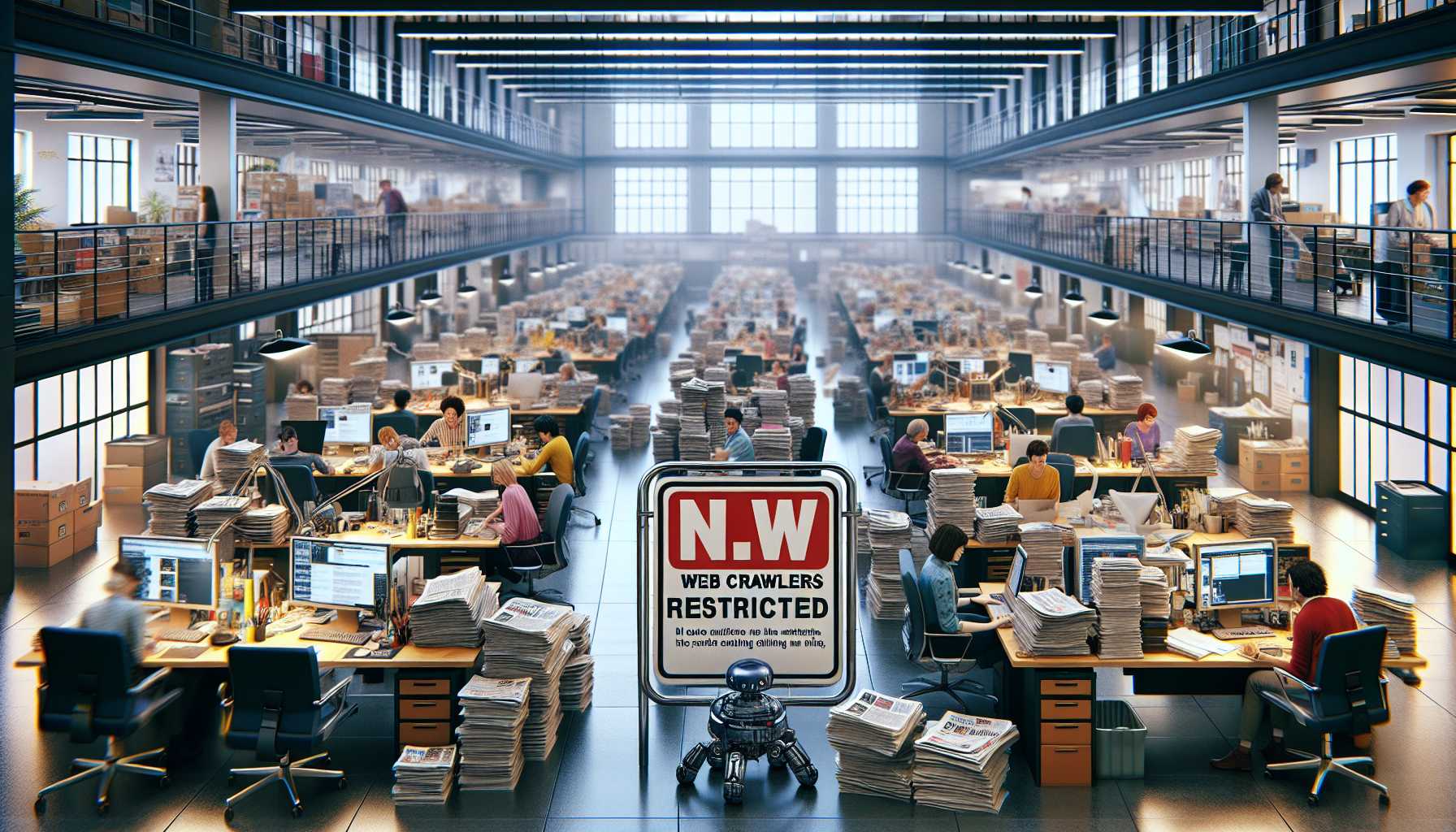# The world of technology is both fantastic and complex, tantalizing us with the promise of a digital utopia while grappling with the very real challenges of integration and security. In this post, we’ll dive into the latest developments that are reshaping our virtual and physical landscapes—from 3D meetings in Microsoft Teams and Google Pixel’s latest hiccup to the trustworthiness of AI-generated summaries and cutting-edge advancements in autonomous robotics. Buckle up, because the digital revolution doesn’t hit the brakes!
1. The Third Dimension of Team Collaboration: Microsoft Mesh in Teams
 Imagine joining your next work meeting not just through a flat video screen but by stepping into a vibrant, three-dimensional virtual space. Well, the future has docked at our station, folks, as Microsoft launches its immersive 3D meetings within Microsoft Teams, thanks to the intrepid integration of Microsoft Mesh. Think of it as a corporate spin on social VR platforms—a medium where business meets modernity in a grand spectacle of avatars and virtual bean bag tosses. While I must admit that nothing beats the charm of in-person interactions, there’s a certain allure to conferencing with colleagues as avatars, especially when it offers features like spatial audio that mirror private office chit-chats by virtually ‘moving away’ from the crowd. Microsoft is initially favoring Meta’s Quest devices for this adventure, urging us to wonder: could this be a strategic alliance or simply a choice of convenience? As we gear up our virtual selves for the boardrooms of cyberspace, Microsoft’s move may be the game changer in remote work culture.
Imagine joining your next work meeting not just through a flat video screen but by stepping into a vibrant, three-dimensional virtual space. Well, the future has docked at our station, folks, as Microsoft launches its immersive 3D meetings within Microsoft Teams, thanks to the intrepid integration of Microsoft Mesh. Think of it as a corporate spin on social VR platforms—a medium where business meets modernity in a grand spectacle of avatars and virtual bean bag tosses. While I must admit that nothing beats the charm of in-person interactions, there’s a certain allure to conferencing with colleagues as avatars, especially when it offers features like spatial audio that mirror private office chit-chats by virtually ‘moving away’ from the crowd. Microsoft is initially favoring Meta’s Quest devices for this adventure, urging us to wonder: could this be a strategic alliance or simply a choice of convenience? As we gear up our virtual selves for the boardrooms of cyberspace, Microsoft’s move may be the game changer in remote work culture.
2. Pixel’s Peculiar Problem: A Troublesome Update
 Not all that glitters with updates is gold, a saying that Google Pixel owners would attest to after the January 2024 update debacle. Picture this: you casually update your phone, only to find your apps crashing, your media unplayable, and the camera turned into an expensive paperweight. It’s like watching a digital utopia crumble before your very eyes. However, let’s reflect on the transparency and responsiveness of the behemoth that is Google—an admirable trait in today’s corporate landscape. But this also raises the question of the adequacy of the company’s QA process. As we play a waiting game for the fix, could this be a wake-up call for tech giants to place as much emphasis on stability as they do on innovation?
Not all that glitters with updates is gold, a saying that Google Pixel owners would attest to after the January 2024 update debacle. Picture this: you casually update your phone, only to find your apps crashing, your media unplayable, and the camera turned into an expensive paperweight. It’s like watching a digital utopia crumble before your very eyes. However, let’s reflect on the transparency and responsiveness of the behemoth that is Google—an admirable trait in today’s corporate landscape. But this also raises the question of the adequacy of the company’s QA process. As we play a waiting game for the fix, could this be a wake-up call for tech giants to place as much emphasis on stability as they do on innovation?
3. AI-Generated Summaries on Amazon Reviews: Can We Trust Them?
 Now, let’s switch gears to the curious case of AI-generated summaries of product reviews on Amazon. In one corner, there’s the convenience of swiftly digesting the essence of thousands of customer experiences. In the opposite corner, we stand face to face with the formidable foes of inaccuracy and misinformation. The challenge with AI isn’t just the odd mix-up between ‘paw pads’ and ‘psa pads’ but the ripple effect of seemingly minor errors eroding consumer trust. It’s the clashing titans of efficient summarization and the enigmatic nature of AI that doesn’t quite understand our products—and our puns—as well as we’d hope. As Amazon seeks to refine its review highlights, they tread a fine line between advancing useful technology and keeping the ‘human’ in the human touch.
Now, let’s switch gears to the curious case of AI-generated summaries of product reviews on Amazon. In one corner, there’s the convenience of swiftly digesting the essence of thousands of customer experiences. In the opposite corner, we stand face to face with the formidable foes of inaccuracy and misinformation. The challenge with AI isn’t just the odd mix-up between ‘paw pads’ and ‘psa pads’ but the ripple effect of seemingly minor errors eroding consumer trust. It’s the clashing titans of efficient summarization and the enigmatic nature of AI that doesn’t quite understand our products—and our puns—as well as we’d hope. As Amazon seeks to refine its review highlights, they tread a fine line between advancing useful technology and keeping the ‘human’ in the human touch.
4. The Butterfly Effect in Generative AI: The Prompting Quagmire
 What’s in a prompt? Well, if you’re talking to generative AI, it might just be the difference between a torrential downpour of insight and a bewildering blizzard of blunders. The research out of the University of Southern California proves just how delicate the balance is when interacting with large language models. A misplaced space, a tweaked format, or even an extra politeness could send AI spiraling down the unpredictability vortex. If we spawn chaos with a simple ‘Hello’, it begs the question: how can we wield such a powerful and sensitive technology faithfully? As someone always eager to push the boundaries, the possibilities are thrilling. Yet, one can’t help but feel the tremor of uncertainty from the unknown variables in AI’s genomic code.
What’s in a prompt? Well, if you’re talking to generative AI, it might just be the difference between a torrential downpour of insight and a bewildering blizzard of blunders. The research out of the University of Southern California proves just how delicate the balance is when interacting with large language models. A misplaced space, a tweaked format, or even an extra politeness could send AI spiraling down the unpredictability vortex. If we spawn chaos with a simple ‘Hello’, it begs the question: how can we wield such a powerful and sensitive technology faithfully? As someone always eager to push the boundaries, the possibilities are thrilling. Yet, one can’t help but feel the tremor of uncertainty from the unknown variables in AI’s genomic code.
5. The AI News Blockade: Data Hoarding or Strategic Play?
 In a move that’s part chess, part digital fortress, major news outlets have erected a rampart against the digital siege engines of AI. But glance over the landscape, and you’ll notice that right-wing media outlets stand as the holdouts. It’s a fascinating tableau of politics, technology, and strategy. Is this a calculated gambit to influence AI’s political palette, or simply a conservative lack of concern for information-sharing boundaries? While AI’s training diet becomes alarmingly partisan, it brings to light the complex dynamics between the free flow of information and the weaponization of data. This isn’t just about whose articles fuel the knowledge base—it’s about the integrity of the information ecosystem and the philosophical debate over the AI’s role in mirroring—or challenging—our societal perspectives.
In a move that’s part chess, part digital fortress, major news outlets have erected a rampart against the digital siege engines of AI. But glance over the landscape, and you’ll notice that right-wing media outlets stand as the holdouts. It’s a fascinating tableau of politics, technology, and strategy. Is this a calculated gambit to influence AI’s political palette, or simply a conservative lack of concern for information-sharing boundaries? While AI’s training diet becomes alarmingly partisan, it brings to light the complex dynamics between the free flow of information and the weaponization of data. This isn’t just about whose articles fuel the knowledge base—it’s about the integrity of the information ecosystem and the philosophical debate over the AI’s role in mirroring—or challenging—our societal perspectives.
6. Gazing into the Future’s Crystal Ball: Israeli Startup’s AI-Powered Agriculture Robots
 From the trenches of software skirmishes to the serene pastures of agritech, the Israeli startup Bluewhite is plowing a new path with its autonomous tractor robots. This agricultural advance could be the dawn of a new era where robots attend to our crops, leaving farmers to manage their estates with calculated precision from afar. The tingling excitement of innovation is palpable as one imagines the sprawling farms tended by AI guardians. But the serenity comes with a side of societal pondering—are we ready to embrace such a disruptive farmhand?
From the trenches of software skirmishes to the serene pastures of agritech, the Israeli startup Bluewhite is plowing a new path with its autonomous tractor robots. This agricultural advance could be the dawn of a new era where robots attend to our crops, leaving farmers to manage their estates with calculated precision from afar. The tingling excitement of innovation is palpable as one imagines the sprawling farms tended by AI guardians. But the serenity comes with a side of societal pondering—are we ready to embrace such a disruptive farmhand?
7. Perspectives on a Personal Tech Evolution: Nostalgia and the Modern PC Landscape
 Turning introspective, I can’t help but reminisce about the days of yore when building a mid-range PC didn’t require auctioning off a small island. You could feel the electric thrill of configuring and upgrading your machine without the shadow of financial ruin looming over. Today’s world, however, has us wonder if the DIY vigor is getting lost in the translation to today’s prohibitive costs and complex tech. Is the golden age of the personal, ground-up approach to computing disappearing into the byte-size fog of history?
Turning introspective, I can’t help but reminisce about the days of yore when building a mid-range PC didn’t require auctioning off a small island. You could feel the electric thrill of configuring and upgrading your machine without the shadow of financial ruin looming over. Today’s world, however, has us wonder if the DIY vigor is getting lost in the translation to today’s prohibitive costs and complex tech. Is the golden age of the personal, ground-up approach to computing disappearing into the byte-size fog of history?
8. When Reality Mimics Sci-Fi: BMW’s Humanoid Robot Workers
 And finally, we have BMW signing up a team of humanoid robots for their factories. This blurring of sci-fi fantasies and assembly line reality leaves us in awe, questioning the relentless transformation of the traditional workplace. As robots prepare to take on tasks of varying complexity, we’re left to ponder the consequences and opportunities of this tech-powered staffing evolution. In an industry traditionally dominated by mechanical arms and conveyor belts, this leap into humanoid automation could either be a stroke of genius or a symptom of overzealous tech enthusiasm. Either way, it’s a front-row seat to the unfolding of a new industrial chapter. In conclusion, the tech industry is spinning at a dizzying velocity, constantly challenging us to adapt or be left in the digital dust. Whether it’s the virtual reality of work meetings, the pitfalls of new updates, the enigmas of AI trustworthiness, or the embrace of robotics in agriculture and industry—tech’s narrative continues to be as compelling as ever.
And finally, we have BMW signing up a team of humanoid robots for their factories. This blurring of sci-fi fantasies and assembly line reality leaves us in awe, questioning the relentless transformation of the traditional workplace. As robots prepare to take on tasks of varying complexity, we’re left to ponder the consequences and opportunities of this tech-powered staffing evolution. In an industry traditionally dominated by mechanical arms and conveyor belts, this leap into humanoid automation could either be a stroke of genius or a symptom of overzealous tech enthusiasm. Either way, it’s a front-row seat to the unfolding of a new industrial chapter. In conclusion, the tech industry is spinning at a dizzying velocity, constantly challenging us to adapt or be left in the digital dust. Whether it’s the virtual reality of work meetings, the pitfalls of new updates, the enigmas of AI trustworthiness, or the embrace of robotics in agriculture and industry—tech’s narrative continues to be as compelling as ever.








